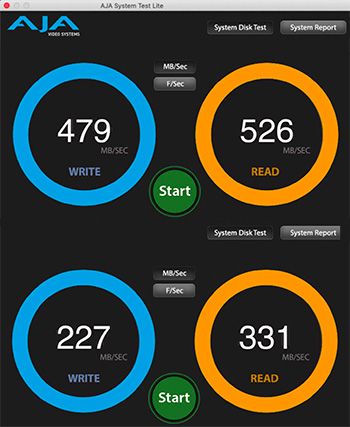Tip #1300: A Hidden SSD Speed Boost
… for Codecs & Media
Tip #1300: A Hidden SSD Speed Boost
Larry Jordan – LarryJordan.com
SSDs don’t have seek times or latency. This means MUCH faster storage speeds for multiple apps accessing storage at once.


OK, I admit, I was playing. But I discovered something very intriguing about SSDs. Watch.
As we’ve learned over the last several tips, the speed of spinning hard drives are limited by seek times and latency (Tip #1287)
The speed of a network is limited by how the devices are connected to it (i.e. 100 Mb vs. 1 Gb vs. 10 Gb Ethernet), the number of users and the connected speed of the server.
But, direct-connected SSDs don’t have these limitations. Instead, speeds are controlled based upon the construction and connection protocol of the SSD (PCIe vs. NVMe – and – USB vs. Thunderbolt).
I plan to do this test in more detail in a few weeks, when I get a chance to play with a brand-new, high-performance NVMe SSD.
But, for this quick check, I connected a Samsung T-5 SSD to a 2019 Mac mini running Thunderbolt 3. While the Thunderbolt 3 protocol maxes out around 2500 MB/sec, the T-5 pegged the meter at 479 MB/s write and 526 MB/s read (see the top values in the screen shot).
HOWEVER, when I ran BOTH AJA System Test and Blackmagic Disk Speed Test at the same time, while the speed for each application dropped, the aggregate speed was FASTER than the speed for the isolated test.
NOTE: In my example, the single app read speed was about 525 MB/s. When both apps were running, the aggregate speed was about 660 MB/s!
What this means is that if you have multiple applications reading or writing to SSD storage at the same time – which is typical for many media apps – SSDs provide far less of a slow-down than spinning media because we can access all that storage directly, without waiting for platters to spin and heads to jump into place.
These tests are just preliminary – I’ll have more on this in a few weeks. But I think this is very, VERY interesting!


This is really tough to benchmark. I have found that even with spinning drives, copying two files simultaneously using finder is faster than two sequentially, but this is not because the drive is capable of parallel operation, but because Finder handles this more efficiently. I have never tried this using two benmarking apps at once though. That was a very interesting idea. Solid state storage is, in theory, capable of parallel operations but apparently most everything else in the communications chain is not… yet. SATA is apparently not capable of parallel operations, but PCIe and NVMe are, in theory.
Tod:
Good points. I’m looking forward to spending more time testing this later this month.
Larry